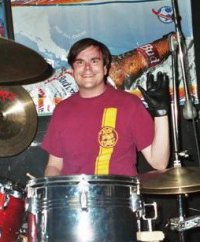Like a lot of Westerners, I first became aware of the art of Japanese taiko drumming in the late 1980s, courtesy of the group Kodo. A PBS documentary about the group had become hugely popular, and I went to see a show of theirs in Princeton, NJ that I still remember as one of the most transfixing and utterly unique live performances I’ve ever seen. Today, taiko groups are popping up all over the world, and the Taiko Nation concert at Japan America Theater – the centerpiece of the 2014 World Taiko Gathering happening in LA during the preceding week – presented excellent groups from England and Australia in addition to the expected guests from Japan (including one former and one current member of Kodo) and LA’s own TAIKOPROJECT.
As so often happens when specifically Eastern traditions start being adopted by primarily white groups, subtle differences in approach start to emerge. Exeter’s Kagemusha Taiko performed a rhythmic rendition of the traditional”Sir Roger De Coverley” in 9/8 time, and you could imagine yourself in a pub, surrounded by bodhrans and pennywhistles. TAIKOPROJECT is always looking for a collaboration, having appeared with Stevie Wonder, Justin Bieber and Kanye West among numerous others, and they straddle the East-West balance the most delicately of all the groups. TaikOz, from Sydney, incorporated impressive dance moves into their routines, which seemed kind of odd at first, but a little old-fashioned showmanship never hurt anybody. The dynamic complexity of the music kept it at least a few steps ahead of Stomp! territory at all times.
While the diversity of the English, American and Australian teams was impressive (great to see so many women among the players), and their compositions respectful of taiko tradition even as they took liberties with it, it was the Japanese visitors that gave the most masterful performances. That’s only fair, since these actually were some of the world’s masters of the art. Soloist Taro Kobayashi dazzled the crowd playing two solos with one drum – all you need when you can play it that well. The trio of Eiichi Saito, Kaoru Watanabe and dancer Chieko Kojima did a long, heavily improvised piece that had the audience hypnotized, drawn in to the delicate sounds coming from the stage. This was taiko at its most restrained and fragile, a contrast to the thunderous pounding that drove much of the program.
Grand Master Seiichi Tanaka, known as the “father of American taiko,” was on hand to perform his composition “Tsunami” with TAIKOPROJECT at the close of the show, a performance intense enough to blow the roof off the packed theater. Watching this music played well is physically impressive, like watching someone break cinderblocks with their bare hands. This is a different kind of showmanship, the kind of thing that you watch, and can tell, this person has spent decades of his or her life getting ready to do this.
Most fun of all were the young Japanese group Sen-Rai. They play this ancient-sounding music with the enthusiasm of a hungry rock and roll band, and have little trouble getting the audience to join in and clap a steady beat through a fairly complex rhythm. I was quite impressed with the crowd’s ability to stay on point when I remembered, oh yeah, this is a drumming convention – everyone here is a drummer. Next year, they should give drums to everyone in the audience, and make them learn “Tsunami” before they can claim their tickets. That’s the only thing I can think of that might make for a more impressive drum sound than the one we heard at this show.



